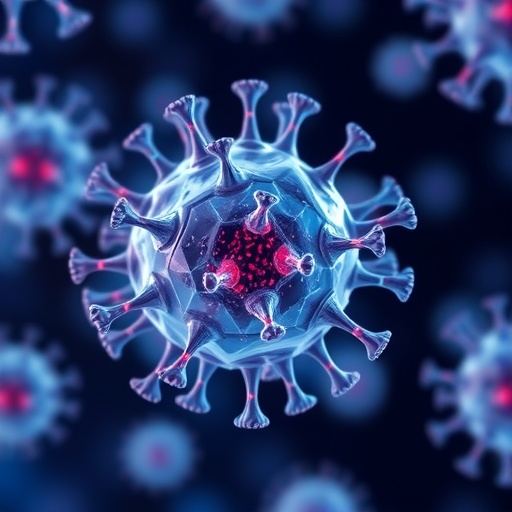In a groundbreaking advance that could revolutionize cancer immunotherapy, researchers have unveiled a novel strategy that targets the protein PCSK9 to modulate the STING signaling pathway, achieving both safety and efficacy in activating immune responses against tumors. This new approach, reported by Sun, Han, Li, and colleagues in Nature Communications, represents a paradigm shift in how immune pathways can be precisely tuned to overcome the limitations of current immunotherapies, which often face challenges of toxicity, resistance, or suboptimal activation of the immune system.
The cGAS-STING axis is a critical component of the innate immune system, serving as a cellular sentry that detects aberrant DNA in the cytoplasm, such as that derived from tumors or viral infections. Upon activation, STING initiates a cascade that leads to the production of type I interferons and other cytokines, thereby alerting and recruiting the adaptive immune system to eradicate malignant cells. However, the spatiotemporal dynamics of STING activation—how it activates in specific cellular compartments and at precise times—is a key determinant of whether this signaling leads to beneficial tumor suppression or harmful systemic inflammation.
The innovative work by Sun et al. elucidates the role of PCSK9, a protein classically known for its regulation of cholesterol metabolism, as a previously unappreciated modulator of STING pathway activation within cancer immunotherapy contexts. By silencing PCSK9, the research team discovered that it is possible to recalibrate the spatial and temporal activation of STING, effectively reshaping the immune landscape to optimize antitumor responses while minimizing toxic side effects commonly associated with STING agonists.
Their findings challenge the long-held notion that PCSK9’s function is confined to lipid regulation and broaden its significance into immuno-oncology. The team employed sophisticated genetic silencing techniques to impair PCSK9 expression in tumor-bearing models, observing a distinctive pattern of STING activation that balanced early, localized immune signaling with sustained systemic immunity. This dual-phase activation is crucial, as premature or excessive STING activation is known to provoke detrimental inflammation, while insufficient activation fails to mount an effective tumoricidal immune response.
One of the remarkable technical aspects of this study is how the researchers employed time-resolved imaging and biochemical assays to trace the intracellular trafficking and activation kinetics of STING. These analyses revealed that PCSK9 silencing enhances STING retention within the endoplasmic reticulum and promotes its subsequent translocation to endosomal compartments at optimal time points, a spatial redistribution that fine-tunes signaling potency. This intricately controlled migration of STING facilitates a more robust yet controlled cytokine secretion profile, which underpins effective immune priming against tumors.
Furthermore, the researchers integrated transcriptomic and proteomic analyses to map the downstream immune pathways affected by this intervention. Their data illuminated increased expression of critical interferon-stimulated genes and markers of dendritic cell activation, signaling a strengthened bridge between the innate and adaptive immune systems. This comprehensive interrogation underscores the systemic impact of PCSK9 silencing beyond mere checkpoint regulation, suggesting a broader reprogramming of tumor immunogenicity.
In vivo experiments presented compelling evidence that combining PCSK9 silencing with existing immune checkpoint inhibitors—such as anti-PD-1 antibodies—synergistically enhances tumor regression without exacerbating systemic toxicity. This finding holds substantial clinical relevance as it offers a blueprint for integrating precision-engineered immune interventions with mainstream therapies to overcome tumor resistance and improve patient outcomes.
The safety profile emerging from these results is particularly notable given the historical challenges associated with STING agonists, which have frequently triggered severe inflammatory responses and off-target effects. By harnessing PCSK9 silencing as a regulatory mechanism, STING activation becomes more predictable and controllable, reducing the risk of adverse events that have hindered the broader application of STING-targeted therapies.
Implications for the future of immunotherapy extend even further, as this work opens avenues to explore PCSK9’s role in other immune cells and contexts. The ability to manipulate the spatiotemporal characteristics of immune pathways suggests new frontiers in personalized medicine, where immune activation patterns could be tailored to individual patient tumor profiles and treatment histories.
The study also highlights the intricate interplay between metabolic pathways and immune regulation within the tumor microenvironment. The recognition of PCSK9—a metabolic regulator—as a pivotal immune modulator underscores the growing appreciation for the metabolism-immunity interface, which is emerging as a critical axis in cancer biology and therapy.
Technically, the research exemplifies how multidisciplinary approaches, combining molecular biology, immunology, advanced imaging, and systems biology, can converge to yield transformative insights. The precision with which the team modulated PCSK9 expression and mapped downstream signaling events sets a new standard for mechanistic studies aiming to translate molecular discoveries into therapeutic realities.
From a broader perspective, this work demonstrates the potential of re-examining established molecular players through the lens of emerging immunological functions. Proteins like PCSK9, traditionally pigeonholed into static biological roles, may harbor unexplored capabilities that can be leveraged in innovative therapeutic strategies, particularly in complex diseases such as cancer.
The translation of these laboratory findings into clinical trials and eventual patient care will be critical next steps. The promising preclinical evidence suggests that therapies targeting PCSK9-mediated modulation of STING could offer dual benefits: potent anti-cancer immunity on the one hand, and a reduction in immune-related adverse events on the other, addressing two major challenges in oncology.
This research not only pushes the boundaries of cancer immunotherapy but also enriches our understanding of fundamental immune signaling pathways. As the field continues to evolve rapidly, strategies that manipulate the spatiotemporal aspects of immune activation will likely become central to next-generation treatment paradigms.
In conclusion, the pioneering work by Sun and colleagues marks a significant milestone, demonstrating that silencing PCSK9 can strategically reshape the spatiotemporal activation of STING, achieving a safer and more effective cancer immunotherapy. This discovery holds the promise to invigorate ongoing efforts to harness the immune system in the fight against cancer, potentially transforming patient outcomes worldwide.
Subject of Research: Cancer Immunotherapy via modulation of PCSK9 and STING signaling pathway.
Article Title: Silencing PCSK9 reshapes the spatiotemporal activation of STING for safe and effective cancer immunotherapy.
Article References:
Sun, P., Han, F., Li, X. et al. Silencing PCSK9 reshapes the spatiotemporal activation of STING for safe and effective cancer immunotherapy. Nat Commun (2025). https://doi.org/10.1038/s41467-025-66630-x
Image Credits: AI Generated
Tags: cellular compartment dynamicsimmune response against tumorsimmune system precision tuninginnate immune system activationnovel cancer treatment strategiesovercoming immunotherapy challengesPCSK9 cancer immunotherapyresistance to cancer therapiesspatiotemporal STING activationSTING signaling pathway modulationtoxicity in cancer treatmentstype I interferons production





